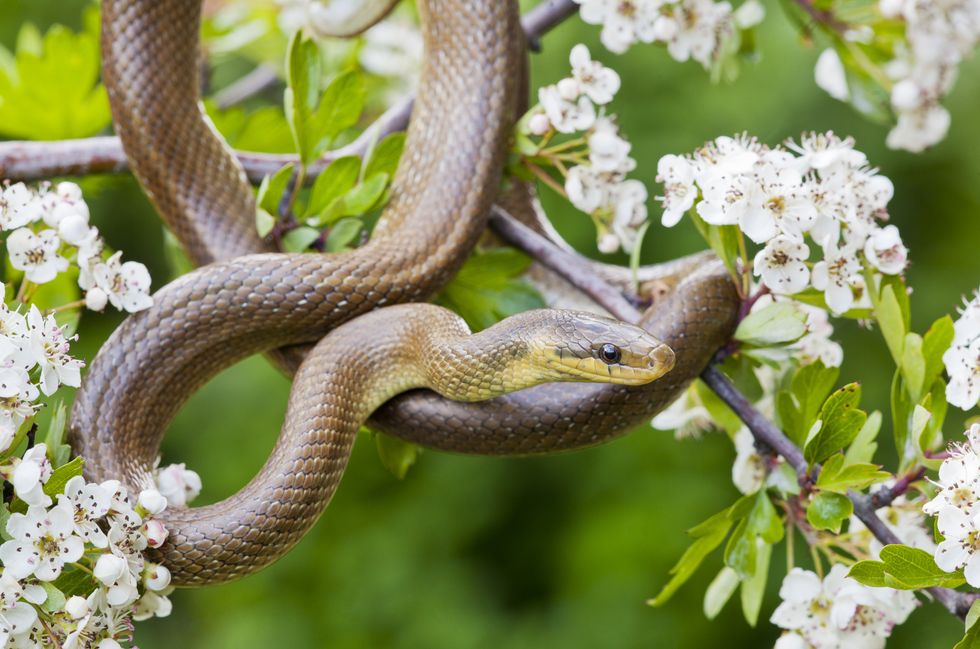Susanna Siddell
Guest Reporter
Giant snakes measuring up to 6.5 feet in length are now making themselves at home in British houses, scientists have warned.
The Aesculapian snake, Europe's largest snake species, has been discovered thriving in residential areas across Wales and - more surprisingly - the heart of London.
These non-venomous reptiles have found an ingenious way to survive Britain's chilly climate by seeking shelter in attics and wall cavities.
A new study has revealed that the snakes are actively seeking out and repeatedly returning to inhabited buildings.

The creatures, which can grow longer than the average person's height, have established stable populations in parts of the UK after being accidentally introduced.
"They were frequently entering buildings – relatively warm refuges – while they were digesting food or preparing to shed their skin," explained Dr Tom Major, one of the study's researchers.
Currently, Britain's Aesculapian snake populations are limited to two locations - along the Regent's Canal in London and around Colwyn Bay in Wales.
The Welsh population emerged in the 1970s following an unexpected escape from the Welsh Mountain Zoo, when an unknown number of snakes fled after their enclosure collapsed, subsequently establishing a breeding population in the surrounding area.
While these snakes typically inhabit the warmer climates of southern Europe, from Spain to the Caucasus, their "climate envelope" is shifting northward, allowing the snakes to flourish in these specific UK locations.
The species was actually native to Britain some 300,000 years ago before being wiped out during an Ice Age.
LATEST DEVELOPMENTS:
Researchers fitted radio trackers to 21 Aesculapian snakes in Colwyn Bay and observed the snakes using garden compost bins for shelter and egg incubation.
The tracking study, published in PLOS One, revealed that male snakes particularly favoured human residences, while females preferred wooded areas.
This behaviour stands out as unusual compared to other British snake species, such as adders and smooth snakes, which typically avoid built-up areas.
The research showed that most residents were unaware of their serpentine neighbours, with the snakes coexisting peacefully with local wildlife.
Despite their impressive size, these snakes pose no threat to humans or pets, experts emphasise.
"Aesculapian snakes are of course perfectly harmless and can just be picked up – even if they bite, the worst consequence would be some very minor scratches," co-author and professor Wolfgang Wüster explained.

The snakes feed primarily on small rodents, with their largest prey being no bigger than a large mouse or vole.
In fact, the snakes are more likely to fall victim to local wildlife and pets than cause any harm.
During the study, several tracked snakes were killed by a buzzard and a house cat, while one of the researchers found that even the smallest dog could easily overpower an Aesculapian snake.
However, if residents discover a snake in their home, they are advised to contact the RSPCA rather than attempt removal themselves.
Despite their invasive status, scientists are calling for these snakes to be protected in the UK.
The Government will soon consider adding Aesculapian snakes to the list of alien species of special concern, which could lead to their eradication.
Find Out More...
The Aesculapian snake, Europe's largest snake species, has been discovered thriving in residential areas across Wales and - more surprisingly - the heart of London.
These non-venomous reptiles have found an ingenious way to survive Britain's chilly climate by seeking shelter in attics and wall cavities.
A new study has revealed that the snakes are actively seeking out and repeatedly returning to inhabited buildings.

The creatures, which can grow longer than the average person's height, have established stable populations in parts of the UK after being accidentally introduced.
"They were frequently entering buildings – relatively warm refuges – while they were digesting food or preparing to shed their skin," explained Dr Tom Major, one of the study's researchers.
Currently, Britain's Aesculapian snake populations are limited to two locations - along the Regent's Canal in London and around Colwyn Bay in Wales.
The Welsh population emerged in the 1970s following an unexpected escape from the Welsh Mountain Zoo, when an unknown number of snakes fled after their enclosure collapsed, subsequently establishing a breeding population in the surrounding area.
While these snakes typically inhabit the warmer climates of southern Europe, from Spain to the Caucasus, their "climate envelope" is shifting northward, allowing the snakes to flourish in these specific UK locations.
The species was actually native to Britain some 300,000 years ago before being wiped out during an Ice Age.
LATEST DEVELOPMENTS:
- Dog owners warned of DEADLY plant after four pets die as poisonous vegetation found on UK shores
- Eleven petrified kittens found after being abandoned in 'squished' box amid -2C temperatures
- Bitter neighbour row escalates after man ordered to pay £2k fine over 'extremely noisy' dogs barking
Researchers fitted radio trackers to 21 Aesculapian snakes in Colwyn Bay and observed the snakes using garden compost bins for shelter and egg incubation.
The tracking study, published in PLOS One, revealed that male snakes particularly favoured human residences, while females preferred wooded areas.
This behaviour stands out as unusual compared to other British snake species, such as adders and smooth snakes, which typically avoid built-up areas.
The research showed that most residents were unaware of their serpentine neighbours, with the snakes coexisting peacefully with local wildlife.
Despite their impressive size, these snakes pose no threat to humans or pets, experts emphasise.
"Aesculapian snakes are of course perfectly harmless and can just be picked up – even if they bite, the worst consequence would be some very minor scratches," co-author and professor Wolfgang Wüster explained.

The snakes feed primarily on small rodents, with their largest prey being no bigger than a large mouse or vole.
In fact, the snakes are more likely to fall victim to local wildlife and pets than cause any harm.
During the study, several tracked snakes were killed by a buzzard and a house cat, while one of the researchers found that even the smallest dog could easily overpower an Aesculapian snake.
However, if residents discover a snake in their home, they are advised to contact the RSPCA rather than attempt removal themselves.
Despite their invasive status, scientists are calling for these snakes to be protected in the UK.
The Government will soon consider adding Aesculapian snakes to the list of alien species of special concern, which could lead to their eradication.
Find Out More...
